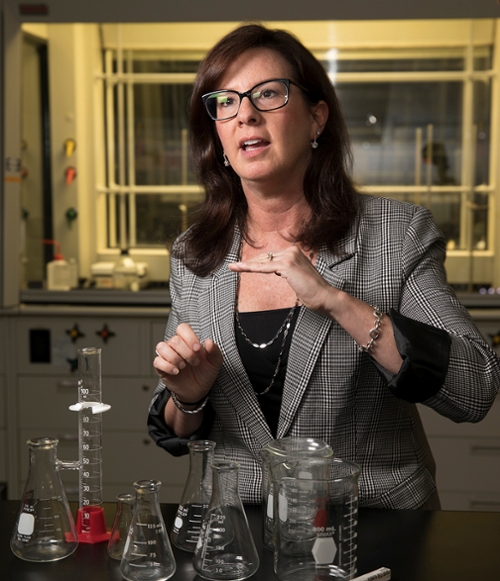

New $1.9M NSF grant will help teachers stimulate students' imaginations to improve learning of chemistry
Project aims to improve high school students’ understanding of chemistry through the use of dynamic visualizations
By Susan Meikle, university news and communications

Ellen Yezierski (by Jeff Sabo)
With a new $1.9 million grant from the National Science Foundation, Miami University’s Ellen Yezierski aims to help high school chemistry teachers prepare students to become more scientifically literate.
Her project has the potential to impact up to 80,000 high school chemistry students from a broad range of socioeconomic, geographic and racial backgrounds, Yezierski said. It will focus on traditionally underserved groups, including English language learners.
Yezierski, a chemistry education researcher, was awarded the five-year grant for her design research in the teaching and learning of high school chemistry through the use of dynamic visualizations — “VisChem” molecular animations designed by Roy Tasker.
These video animations of the molecular world can bring a new dimension to learning chemistry.
The project will develop teachers' knowledge and skills to help their students build molecular-level mental models to explain chemical events, Yezierski said.
Currently, chemistry education overemphasizes description and symbols rather than learning to explain chemical phenomena.
Students becoming informed adults for a changing world
Yezierski will recruit 64 high school chemistry teachers from across the country to participate in the professional development program.
They will learn how to effectively use storyboarding and the VisChem approach to lead students from describing chemical phenomena, such as reactions and physical changes, to understanding and explaining their causes.
One goal is to help high school students become more scientifically literate. The focus is on learning how to reason with chemistry concepts and principles, rather than on memorizing facts, Yezierski said.
Ultimately, students will be better prepared to understand science in areas requiring molecular-level perspectives, and to become informed adults in a changing world, Yezierski said. Some areas include understanding the role of carbon dioxide in climate change, changes in DNA in genetically modified organisms (GMOs), antibiotic resistance and drinking water quality.
VisChem Institutes: Molecular animations, storyboarding for understanding

An example of the VisChem dynamic visualizations. The images from video animations of liquid water (above) and boiling water (below) show differences in molecular activity of different physical states of water (images by Roy Tasker from VisChem.com.au).
Three teacher cohorts — one cohort each over the next three summers — will attend the all-expenses-paid VisChem Institute (VCI) on campus developed by Yezierski.
The institutes will be taught by Yezierski and project consultant Roy Tasker, creator of the VisChem dynamic animation system. “Animations of the molecular world can stimulate the imagination, bringing a new dimension to learning chemistry,” Tasker said.
For instance, few students have a “feel” for the average distance between ions (charged particles) in a solution of a given concentration, according to Tasker.
"VisChem animations of ionic solutions bring meaning to the magnitude of the number expressing molarity (concentration of a chemical in solution), in much the same way that people have a 'feel' for the length of one meter,” Tasker said.
Design research: Supports teachers' learning
Yezierski’s design research involves studying how to support teacher groups in learning chemistry content and instructional methods.
 Teacher cohorts will be supported during the following year after they attend the VCI. Some will be provided with software to run their own molecular simulations. Eventually all teachers will develop and grow a community of skilled practitioners using the VisChem approach.
Teacher cohorts will be supported during the following year after they attend the VCI. Some will be provided with software to run their own molecular simulations. Eventually all teachers will develop and grow a community of skilled practitioners using the VisChem approach.
In their classrooms, teachers will wear tiny GoPro cameras to collect video clips of their teaching. The clips will provide data about what teaching methods are more effective than others.
Those clips will be studied and evaluated by Yezierski and her team to inform and improve the design of future VCIs and improve chemistry teaching with molecular visualizations.
The time is right
Yezierski has been conducting chemistry education and teacher professional development research for the past 16 years. She is nationally recognized for conducting groundbreaking research that improved instruction and student learning as a direct result of Target Inquiry, a visionary professional development model for high school chemistry teachers.
She has a long history with Tasker, having based her doctoral dissertation research on the use of VisChem dynamic visualizations.
She has recently started to see chemistry teachers become more open to/interested in incorporating dynamic visualizations and storyboarding in their teaching.
This approach aligns with the newest Next Generation Science Standards and the recently updated AP chemistry curriculum, Yezierski said.
The team
 Yezierski, professor of chemistry and biochemistry, is also director of Miami’s Center for Teaching Excellence.
Yezierski, professor of chemistry and biochemistry, is also director of Miami’s Center for Teaching Excellence.
She was named an American Chemical Society Fellow in 2016.
An experienced high school chemistry teacher, she taught chemistry for seven years before earning her doctorate from Arizona State University in 2003.
Her research team will include a postdoctoral fellow, two graduate students, several undergrad students and Tasker.
Tasker is a renowned Australian chemistry education researcher. He received the Prime Minister’s Award for Australian University Teacher of the Year in 2011 and the prestigious Australian National Senior Teaching Fellowship in 2014.
He created the VisChem approach in the 1990s, and since then the dynamic visualizations have been adopted by educators and textbook authors internationally.
